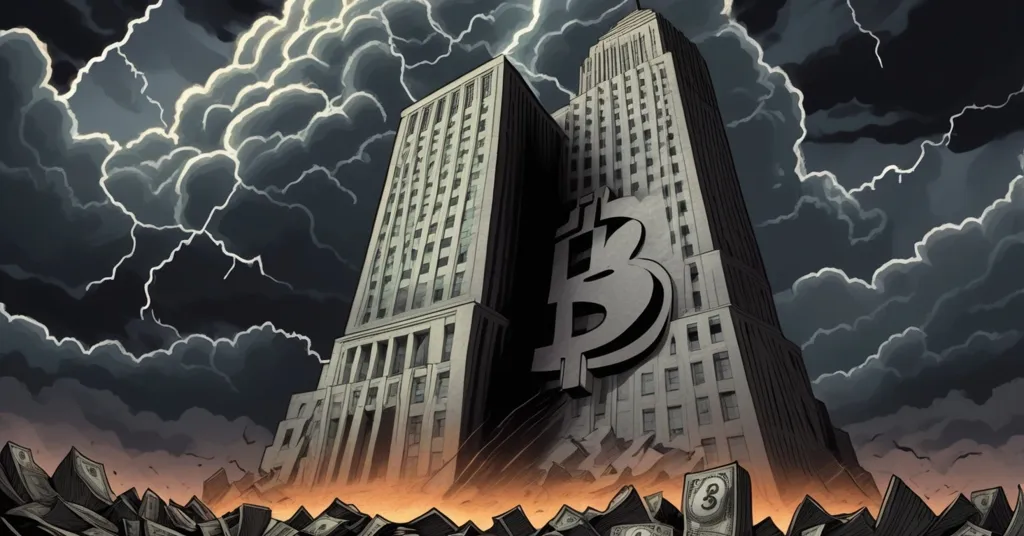Trump Slams Powell Over Fed Rates as Debt Crisis Fuels Bitcoin Appeal

Trump vs. Powell: Fed Rates Battle Heats Up Amid Debt Crisis and Crypto Potential
President Donald Trump is waging war on Federal Reserve Chair Jerome Powell, blasting him as incompetent and pushing for interest rate cuts while the U.S. economy teeters under a $36 trillion national debt. As Powell defends the Fed’s steady stance amid inflation fears tied to Trump’s tariffs, this clash exposes the fragility of centralized finance—and could spark renewed interest in decentralized solutions like Bitcoin.
- Trump’s Fury: Slams Powell as “stupid” for high rates, claiming billions lost in debt interest.
- Fed’s Caution: Rates unchanged for four meetings due to tariff-driven inflation risks.
- Crypto Opportunity: Economic chaos could position Bitcoin as a hedge against fiat woes.
Trump’s War on Rates: A Personal and Policy Attack
The feud between Trump and Powell has reached a boiling point, with the President unleashing a barrage of insults at the Fed Chair during a NATO summit in the Netherlands. Trump didn’t hold back, calling Powell “a very stupid person” and “low IQ” for refusing to slash interest rates, which he claims are costing the federal government hundreds of billions in unnecessary interest payments on a staggering $36 trillion national debt. Trump’s frustration isn’t just rhetoric—he’s already eyeing replacements for Powell, whose term, renewed by President Joe Biden, extends until May 2026. Names like Treasury Secretary Scott Bessent, Fed Governor Christopher Waller, and former Fed Governor Kevin Warsh are in the mix as potential successors, as Wall Street closely monitors the unfolding drama.
“He’s an average mentally person… Low IQ for what he does. I think he’s a very stupid person, actually,” Trump declared about Powell.
Trump’s beef with Powell isn’t just personal; it’s rooted in a fundamental disagreement over monetary policy at a time when the U.S. economy is under immense strain. With a national debt that’s ballooned to unthinkable levels and a proposed tax cut bill that the Congressional Budget Office (CBO) estimates could add another $2.4 trillion over a decade, Trump and his GOP allies see lower rates as a quick fix to ease borrowing costs, a concern highlighted in recent analyses of Trump’s fiscal policies. Commerce Secretary Howard Lutnick echoed this urgency on social media, demanding immediate action from Powell to cut what he called “absurdly high” rates.
“Jerome Powell – your job is to help Americans, not hurt them, so do your job and CUT our absurdly high interest rates at your next meeting,” Lutnick posted.
Powell’s Defense: Stability Over Short-Term Wins
On the other side of this battlefield stands Powell, unwavering during his testimony before the Senate Banking Committee, as reported in coverage of his recent statements. The Federal Open Market Committee (FOMC), the Fed’s policy-making body, voted unanimously to keep rates unchanged for the fourth consecutive meeting. Powell’s reasoning is clear: Trump’s proposed tariffs—a key pillar of his “America First” trade agenda—could spark a “fairly substantial wave of price increases” for consumers as early as this summer. Cutting rates now, he argues, risks reigniting inflation and saddling Americans with long-term economic pain.
“If we make a mistake here, people will pay the cost for a long time,” Powell warned during his testimony.
For those unfamiliar with the Fed’s role, think of it as the thermostat of the U.S. economy. Tasked with a dual mandate of controlling inflation (keeping prices stable) and maximizing employment, the Federal Reserve uses interest rates as its primary tool, a mechanism detailed on resources explaining the federal funds rate. High rates make borrowing more expensive, cooling an overheated economy but hitting government budgets and consumers hard. Low rates do the opposite, spurring growth but risking runaway inflation if money flows too freely. Powell’s caution stems from the real threat of tariffs—taxes on imported goods—driving up costs, a risk underscored in discussions of tariff impacts on inflation. Imagine a $50 tariff on a Chinese-made gadget; that cost often gets passed directly to you, the buyer, jacking up prices across the board.
Inside the Fed, consensus is far from guaranteed. Trump appointees like Fed Vice Chair Michelle Bowman and Governor Christopher Waller push for quicker rate cuts to support the labor market, with Waller dismissing tariff inflation as a “one-off” event. Meanwhile, voices like Chicago Fed President Austan Goolsbee suggest holding steady until the tariff impact clarifies. This internal split only fuels the political fire, with senators like Bernie Moreno of Ohio accusing Powell of sabotaging Trump’s trade agenda, claiming his rate policies have a “$400 billion impact” on the deficit. Public debates on platforms like Q&A forums question Powell’s reluctance to cut rates.
The Debt Bomb Ticking: A Centralized Crisis
Beyond the heated rhetoric, the stakes couldn’t be higher. The U.S. national debt sits at a jaw-dropping $36 trillion, with annual interest payments alone nearing $1 trillion—money that could fund social programs or infrastructure but instead vanishes into a black hole of debt servicing. Trump’s tax cuts threaten to pile on another $2.4 trillion, per CBO estimates, intensifying pressure on the Fed to lower rates and cut borrowing costs. Yet, there’s a darker shadow looming: the debt ceiling. This legal limit on how much the government can borrow must be raised by Congress to avoid a default—a catastrophic scenario where the U.S. can’t pay its bills, akin to maxing out a credit card with no lifeline. Without action, the Treasury faces a potential crisis that could shake global markets.
This mess exposes the fragility of centralized financial systems, where political gridlock and fiscal irresponsibility threaten stability. Every year, the U.S. edges closer to a breaking point, eroding trust in traditional institutions. And when trust falters, where do people turn? For many, the answer lies in decentralized alternatives—systems not beholden to political whims or central bank fumbles. Bitcoin, often dubbed “digital gold,” emerges as a potential escape hatch, a store of value that operates outside the control of any government or Fed Chair, a trend explored in analyses of debt’s impact on Bitcoin adoption.
Bitcoin’s Quiet Opportunity Amid Economic Chaos
The Trump-Powell showdown isn’t just a spectacle for policy wonks; it’s a glaring reminder of why decentralization matters. Bitcoin and the broader crypto space thrive in moments of economic uncertainty. Historically, BTC’s price has spiked during past U.S. fiscal crises—like the debt ceiling standoffs of 2011 and 2013—when investors sought a hedge against fiat devaluation and inflation, a pattern supported by research on Bitcoin as a crisis hedge. With the current debt burden, inflation risks from tariffs, and the specter of default, we could see a similar flight to decentralized assets. If the house of cards that is centralized finance wobbles further, Bitcoin might just become the ultimate middle finger to a broken system.
But let’s pump the brakes on the hype train. Bitcoin isn’t a flawless savior. Its price volatility—think wild swings during high-demand periods like 2017 or 2021—can spook mainstream adopters. Network congestion during those same bull runs exposed scalability limits, raising questions about whether BTC can truly handle mass adoption in a crisis. Regulatory uncertainty looms large too, with governments worldwide itching to clamp down on crypto’s Wild West vibe. Could Bitcoin scale to absorb a flood of new users if fiat systems stumble? That’s a gamble even the most hardcore HODLers might hesitate to bet on.
Beyond Bitcoin, other decentralized players could also capitalize on this chaos. Ethereum, with its smart contract capabilities, offers a platform for decentralized finance (DeFi) applications that could serve niches Bitcoin doesn’t touch—like lending or yield farming without banks. Stablecoins, pegged to fiat but running on blockchain tech, provide a less volatile alternative for payments or savings. These innovations highlight the broader potential of decentralized tech to fill gaps left by centralized dysfunction, even if Bitcoin remains the poster child for financial rebellion.
The “Shadow Fed” and Future Uncertainty
Back in the traditional finance arena, Powell isn’t budging anytime soon. Trump can rant all he wants, but legal protections tie his hands—Powell’s job is safe until May 2026. Still, Trump’s early chatter about replacements has Wall Street buzzing about a “Shadow Fed,” a term for the market uncertainty sparked by speculation over a future Fed Chair who might prioritize low rates over inflation control. Traders worry this could unsettle markets long before Powell’s term ends, potentially fueling more economic instability—and, by extension, more interest in crypto as a safe haven, a topic generating heated discussion on online forums debating Trump vs. Powell.
What’s next? Keep an eye on upcoming Fed meetings for any shifts in rate policy, the debt ceiling deadline for signs of congressional gridlock, and Trump’s next move on Powell. This fight is far from over, and the fallout could ripple through both traditional and decentralized markets. For crypto enthusiasts, it’s a moment to ask: Is Bitcoin ready to step up as a viable alternative, or are we still too tethered to the volatility of its adolescence? The answer might shape the future of finance more than any Fed decision.
Key Takeaways and Questions
- What’s fueling the Trump-Powell conflict over interest rates?
Trump accuses Powell of keeping rates high, costing billions in debt interest, while Powell prioritizes avoiding inflation worsened by Trump’s tariff policies. - Why is the Federal Reserve hesitant to cut rates under pressure?
Powell fears that lowering rates now could unleash inflation, especially with tariffs expected to drive significant consumer price hikes as early as this summer. - How does the $36 trillion U.S. national debt factor into this debate?
The massive debt, coupled with Trump’s tax cuts adding $2.4 trillion more per CBO estimates, pushes calls for rate cuts to ease borrowing costs, while a potential default looms if the debt ceiling isn’t raised. - Could economic uncertainty boost Bitcoin and crypto adoption?
Yes, centralized financial instability and inflation fears often drive investors to Bitcoin as a hedge, with historical spikes during past debt crises supporting this trend. - What risks does Bitcoin face as a mainstream economic hedge?
Volatility, scalability limits seen in past bull runs, and regulatory uncertainty could hinder Bitcoin’s ability to absorb mass adoption during a fiat crisis. - Can Trump replace Powell before his term ends?
No, Trump lacks the legal authority to fire Powell before May 2026, though he’s actively considering successors to influence future policy.



